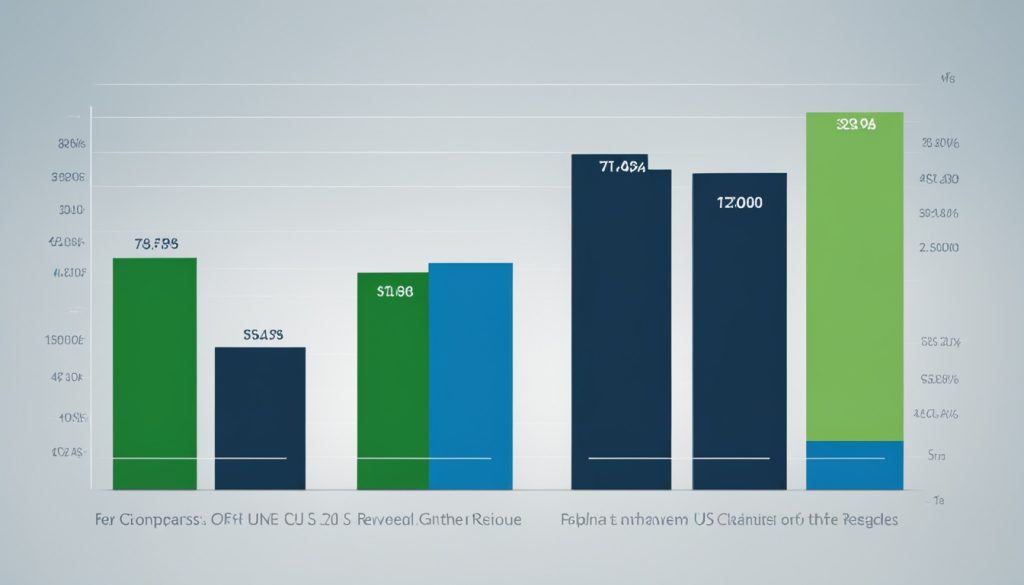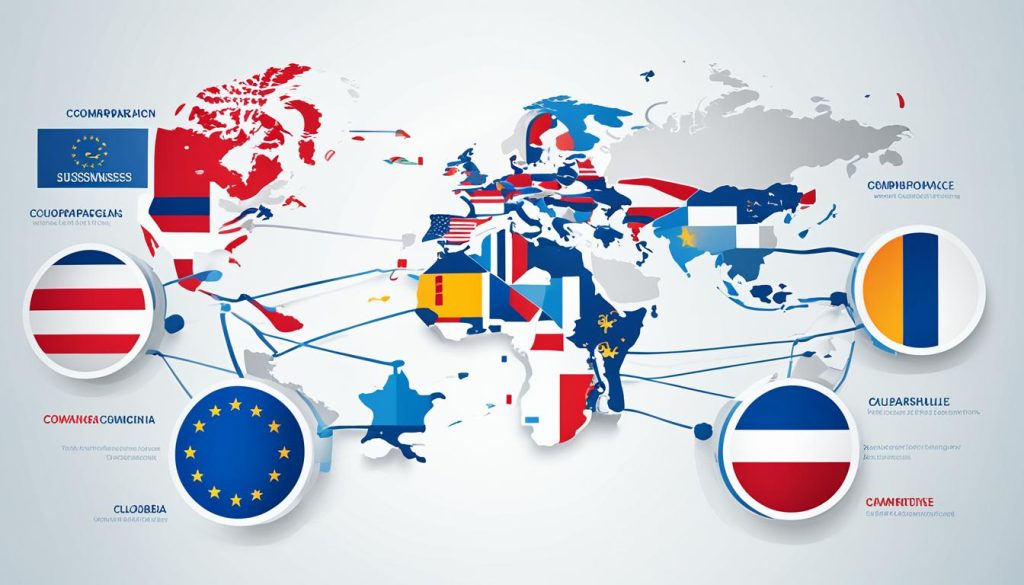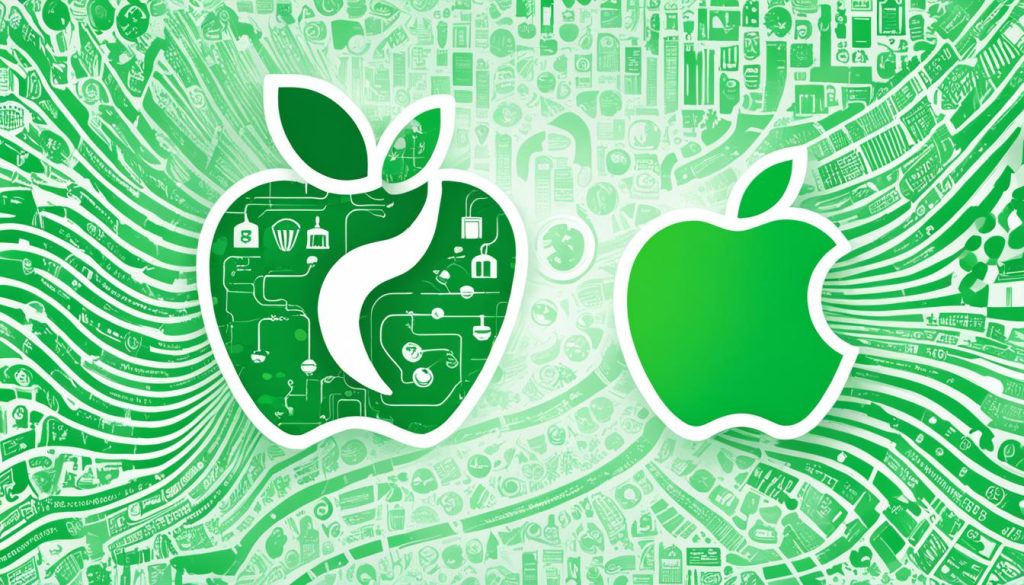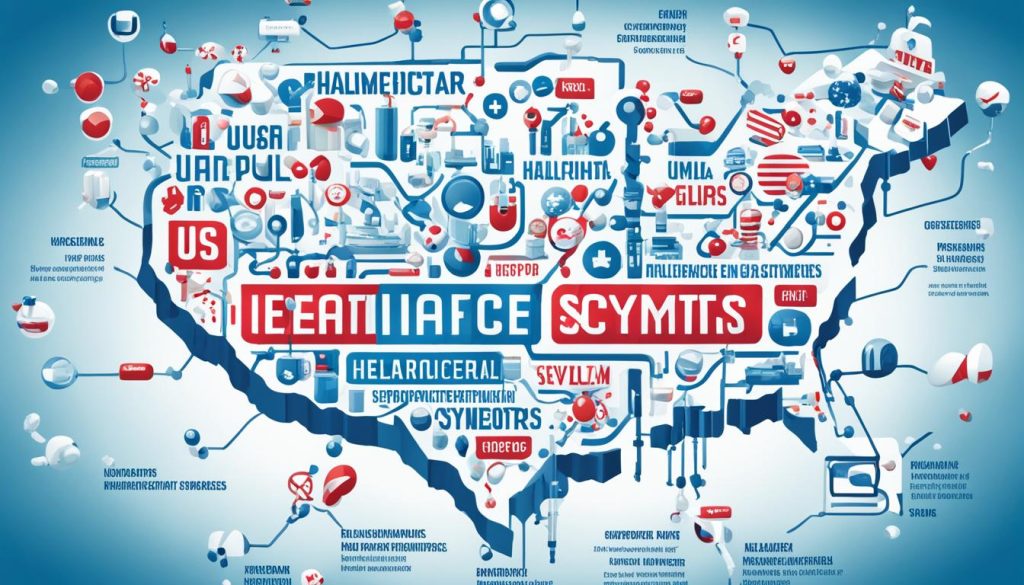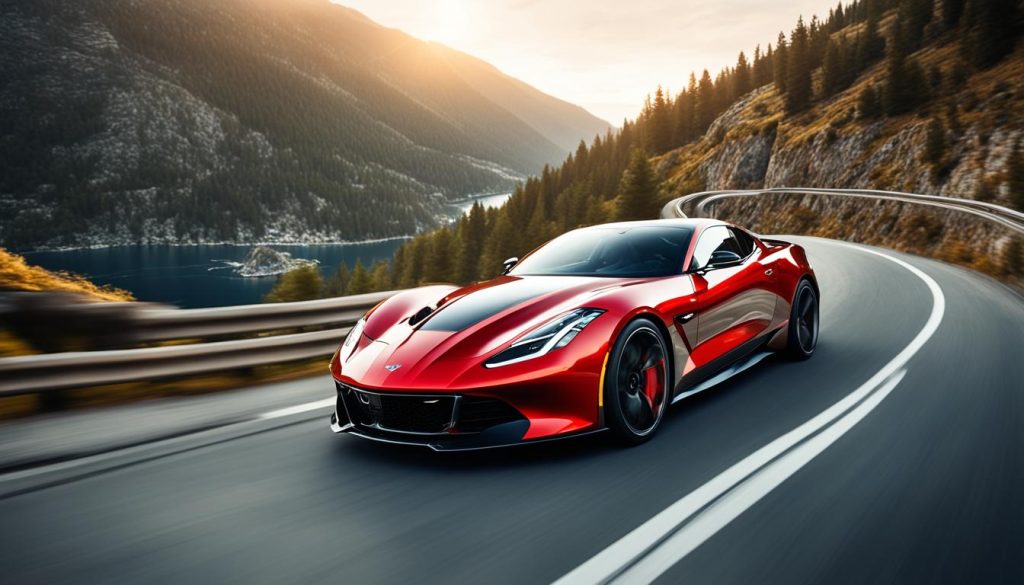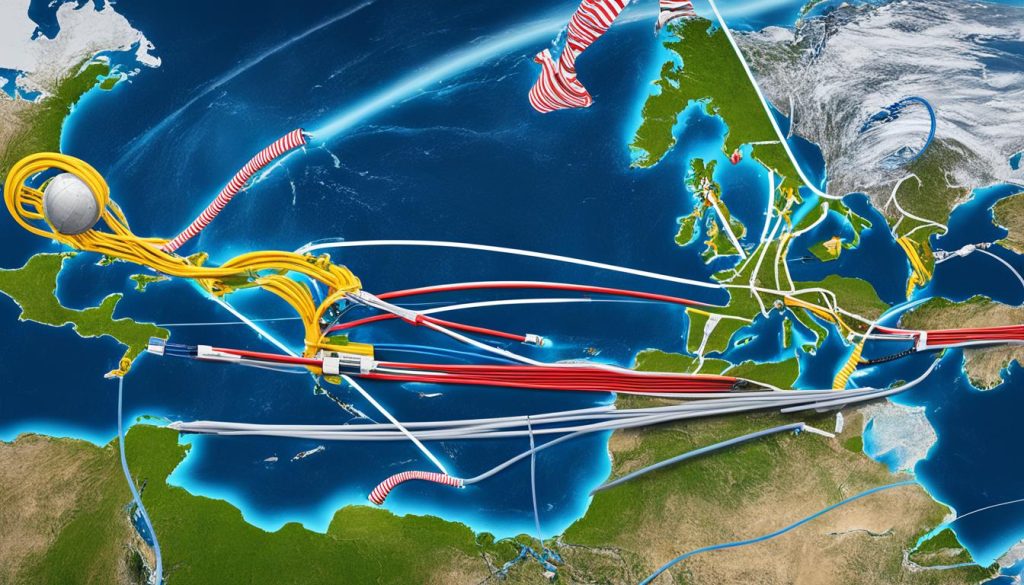The business world across the Atlantic is fascinating. Companies are shaped by where they come from. This comparison looks at the differences and similarities of top US and European companies. We will see how their location, culture, and laws have made them leaders in their fields.
Key Takeaways
- Understanding the impact of distinct market strategies and economic frameworks between US and European companies.
- Analyzing the unique challenges and operational nuances in a transatlantic business context.
- Appreciating how regulations and consumer trends can drive innovation and change in different regions.
- Gaining insights into the importance of historical trade relations on current business practice and comparison.
- Exploring sector-specific variations to encapsulate the diverse business landscape across the Atlantic.
Introduction to Transatlantic Business Comparisons
The global business environment is key in shaping transatlantic trade success and challenges. It highlights the deep economic links and competition between the US and Europe. This relationship has been moulded by globalisation over the years.
Looking at the international market comparison reveals differences in regulation, labour, and consumer trends. These differences influence how businesses operate and compete. They also affect what companies offer in their markets.
- Innovations in technology and business processes are central to this comparison. They highlight the need for businesses to adapt and think ahead.
- Debates about market dominance spotlight the competitive field. They show how companies strive to win customers and expand their market share.
- The economic input of US and European firms impacts global trade, investment, and jobs significantly.
We must explore how the economic roles of these continents anchor the wider global business environment. The next sections will compare different industry sectors. They draw from a rich history that influences today’s business ways.
Tech Titans: Silicon Valley vs European Innovators
The battle between Silicon Valley and European tech startups shows an industry full of competition and teamwork. The rise of digital tech has created innovation hubs in the U.S. and Europe. Silicon Valley is home to giant tech firms, while Europe’s startups offer new ideas, making it a hotbed for tech evolution.
The Rise of Software and Internet Services
Software and internet services are growing fast, thanks to high demand. Silicon Valley is known for big firms with innovative solutions. European startups, however, are making a mark with unique offerings. They use the single digital market to grow quickly across different cultures.
Hardware and Consumer Electronics Evolution
The hardware and electronics world is key to tech’s role in our lives. Silicon Valley shines in design and performance. European startups focus on merging tech with eco-friendliness. They often lead in making the sector more sustainable.
Privacy Laws and Data Security Strategies
Data’s importance today makes its protection critical. Europe’s strict privacy rules, like the GDPR, highlight this. Silicon Valley’s response to privacy is less regulated but still focuses on security. This difference sparks a global discussion on privacy and responsibility.
When comparing the tech sector, both Silicon Valley and European startups have much to offer. They show the technology world’s ability to change and thrive. Together, they might shape a future where working together is as important as competing.
Financial Giants: Wall Street and European Banks
Comparing Wall Street with the European banking system shows a lot about our global economy. The heart of America’s finances, Wall Street, is famous for bold trading and huge market values. European banks, especially in London and Frankfurt, stick to stricter rules partly due to tough regulations and a varied market.
The US and Europe have taken different paths in regulating finance, especially after the global financial crisis. Dodd-Frank Act in America goes one way, while Europe’s Basel III stands for stability. Wall Street is known for taking big risks for big rewards, unlike Europe’s careful approach.
US banks are giants in global market capitalisation, but European banks play a big role too. They have a lot of assets and are essential in worldwide finance. Brexit has made everyone talk more about international banking and financial trading changes.
Global trends and policy changes affect the finance world, touching firms and banks everywhere. It shows how interconnected global finance really is. The impacts of decisions can cross the ocean, influencing markets in both the US and Europe.
As we dive deeper, we might explore:
- How Wall Street banks recovered after the recession compared to European ones?
- What key regulations shape the European banking system, and how do they match up with US policies?
- After Brexit, what’s next for London as a finance centre, and what’s happening in European banking?
- How fintech and digital currencies are changing the game in finance, and how old banks are responding.
The finance world is always moving. Banks in both the US and Europe are navigating through new economic challenges. With updates in trade agreements, politics, and tech, the future of Wall Street and European banking is closely connected and complex.
Healthcare Heavyweights: US Pharma vs European Healthcare Systems
We need to compare healthcare sectors, looking at US pharma companies versus Europe’s healthcare systems. This study sheds light on their impact on medicine, patient care, and the industry.
The Pharmaceutical Industry Landscape
In the US, companies like Pfizer and Johnson & Johnson lead with profit-driven motives. They focus on new developments in health. Europe’s firms balance innovation with providing care that everyone can afford.
Public vs Private Healthcare Paradigms
We’re discussing private versus public healthcare. The US has a private insurance model that affects drug prices and availability. Europe aims for universal healthcare, funded by the government. This impacts how medicines are regulated and what patients pay.
Investment in Medical Research and Development
Investment in medical research varies greatly. The US is at the forefront, prioritising innovation. Europe mixes public and private funding, promoting scientific progress while keeping costs down for the public.
Automotive Industry: American Muscle vs European Elegance
The world’s car market shows a clear division between American and European cars. This isn’t just about different looks; it’s about what these cars represent. American cars are all about power, while European ones are known for elegance.
The types of cars made in the U.S. and Europe reflect this difference. American cars usually have bigger engines, offering a thrilling drive. European cars, though, focus on being efficient and having the latest tech. This makes them popular worldwide.
Now, the car industry is focusing more on being green. Both American and European makers are working on electric cars. They want to make cars that are fast, efficient, and also good for the planet.
- American companies are starting to make exciting electric cars.
- European makers are also creating electric cars that are as stylish as they are green.
Both American and European car industries are working towards a greener future. They’re not just following trends; they’re setting them. They aim to make cars that are better for the environment.
The future of cars looks bright, with both American and European makers focusing on power and sustainability. They’re bringing their traditions of power and elegance into making cars that are good for the planet.
Retail Rulers: The Supermarket Sweep
In looking at the Retail industry analysis, it’s clear that US and European retailers have adapted differently. US supermarkets are huge, offering a wide range of products. This has allowed them to keep prices low and offer lots of different items.
European retailers, meanwhile, are in smaller spaces and focus on quality and convenience. These differences show how culture and infrastructure affect retail in each place.
- US Supermarkets offer everything in one place, meeting customers’ need for convenience.
- European shops focus more on speciality items, sustainability, and local goods.
With e-commerce growing, US and European stores have had to change their approach. They need to keep physical stores appealing while also growing online.
- US supermarkets are boosting their online services, like click-and-collect and delivery.
- European stores mix traditional and online shopping to stay up-to-date in the digital age.
Shopping habits have changed, too. People like buying online for convenience. Yet, many still enjoy going to stores for the experience and to get things right away.
The Retail industry analysis shows intense competition. Both US and European retailers are working hard to win customers with innovations, loyalty programs, and efficient supply chains.
In conclusion, the story of retail across the Atlantic is one of change and toughing it out. As preferences and tech evolve, the retail world will keep transforming in new and unexpected ways.
An In-Depth Analysis of Energy Sector Leaders
The energy sector is crucial to modern economies. It is where the battle between fossil fuels and renewable technology happens. The difference in energy approaches between the US and Europe is very clear. It shows how each place deals with energy use and laws.
Fossil Fuels and Renewable Energy Technologies
In the fossil fuel arena, the US is a big player with its coal, oil, and gas. But, it’s also shifting towards more renewable sources. Europe is ahead in using renewable energy, thanks to countries like Germany and Denmark. They’re doing great with wind and solar power.
- Examining renewable technology investment and development
- Evaluating the balance of traditional energy sources versus green innovations
- Featuring progressive companies leading the charge toward a cleaner future
Environmental Policies and Regulations
Europe leads with its strict environmental laws. It has set ambitious goals for cutting carbon emissions, as seen in the Paris Agreement. These efforts show Europe’s dedication to fight climate change. In the US, the situation is mixed. Its laws can differ greatly from one state to another.
- Assessing the impact of the Paris Agreement on corporate strategies
- Analyzing the US’s embrace of environmental regulation at state and federal levels
- Understanding how public sentiment influences environmental policy and energy sector practices
We are on a path to global sustainability, thanks to changes in the energy sector. Both companies and lawmakers play key roles. They help create a balance between the environment and economic growth. This shows our shared duty to care for the earth’s future.
Telecommunications: Connecting the New World and the Old
The US and European telecoms show how tech, policy, and strategy overlap. This sector is vital for the economy, enabling global info sharing. The US and Europe both have thriving markets that need innovation and investment to grow.
Investment in 5G is a big focus in telecoms. The US is quickly rolling out 5G, while Europe aims for a continent-wide rollout. This effort hopes to boost connectivity and speed up wireless networks. It affects users and the growth of the Internet of Things and smart cities.
- Telecom services vary widely, with Europe liking bundled services and the US preferring flexible options.
- US telecoms often lead with new products, while European ones emphasize service innovation and green practices.
Policies shape telecom operations and competition. The US upholds net neutrality, affecting service delivery. Europe’s Digital Single Market seeks to remove digital borders and promote innovation. These policies guide telecoms in the US and Europe.
- Removing roaming charges in the EU has made consumers happier and changed telecom operations.
- US telecoms face challenges and opportunities due to policy changes and global market shifts.
In summary, US and European telecom industries aim for a connected future. But, their strategies and challenges differ. This shows the variety in how they approach investment, innovation, and policies.
The Titans of Tourism: US Attractions vs European Destinations
Tourist spots in the US and Europe cater to different tastes. In the US, you’ll find everything from the bright lights of Las Vegas to the Grand Canyon’s beauty. Europe, with its rich history, offers things like Paris’s architectural sights and Rome’s ancient ruins.
Travel and Hospitality Industry Trends
The latest trends show a shift towards authentic local experiences. In the US, there’s a focus on unique stays and immersive activities. European spots highlight their cultural past to draw in those seeking to learn. Both areas now also push for greener travel options, aiming for sustainability.
Cultural Heritage and Modern Leisure Economics
When it comes to leisure, the US excels in theme parks and city vacations, boosting its tourism earnings. Europe’s appeal lies in its historical sites and cultural traditions, perfect for those desiring an educational trip. Yet, both are enjoying the perks of a rejuvenated tourism sector, adapting and growing.
Food and Beverage Industry: A Taste of Innovation
The food and beverage sector analysis leads us on a culinary journey. It takes us across the Atlantic to explore creativity in food. Here, innovation in cuisine is changing tastes and how we make food. In the U.S., companies mix different foods and use technology in their services. In Europe, food makers use old methods and new sustainability practices.
Both continents experience big changes, driven by a demand for healthy and ethically sourced foods. The push for innovation is more than just food; it’s about tech and eco-friendly packaging too. The industry focuses on sustainability with biodegradable materials and less waste. It also reflects changing tastes with new global flavours.
The U.S. loves quick food that’s still tasty, leading to more plant-based options and tech in delivery. Europe, though, keeps its unique food traditions. Each country there offers special dishes that are historic yet modern.
- Technology meets sustainability in city farming and vertical gardens.
- Knowing where food comes from marks quality and transparency.
- Modern dining now includes unique tastes and health-focused nutrition plans.
Trade deals and farm policies are big parts of this food story. They affect what we grow, how we move it, and what we eat. There’s a big push for organic and locally sourced food. This changes trade and market demands, making food industries adapt and change.
This food and beverage sector analysis shows a special shift. The mix of old and new in food innovation is not just a phase. It’s proof of an industry vital in cultural and environmental change.
Media Moguls: Broadcasting Across the Pond
The media industry is vast, with US powerhouses and Europe’s giants at the forefront. Their strategies in broadcasting show stark differences, shaped by culture and rules.
In the US, big companies dominate broadcasting. They create and share a wide range of content, from TV shows to movies. Yet, the Federal Communications Commission (FCC) keeps a close eye. It ensures they follow rules that affect their operations.
Europe offers a contrast with a focus on public service and local content. The European Broadcasting Union (EBU) supports this. They embrace diversity, supporting local talent and unique shows. Streaming services here also thrive, offering non-English language programs that attract viewers worldwide.
- US media giants focus on making money and expanding their brands.
- European broadcasters aim to enrich culture and provide public service.
- Streaming services are shaking up the norm, with US and European players competing for viewers.
- The FCC and EBU set the rules, ensuring fair competition in the digital world.
The broadcasting scene in the US and Europe is taking different roads but also finding common ground. Mergers and partnerships are happening. This gives global audiences more choices, shaping the future of broadcasting.
Aerospace and Defence: Sky-High Competition
The aerospace and defence sector is crucial. It shows the strength of nations and big companies. This isn’t just about money but also about being a leader. The battle between the US and Europe in this field is interesting. It’s all about who can innovate more and grab more contracts. This is driven by the alliances that control military power and space exploration.
Military Contracts and International Relations
In the world of military contracts, American firms often have the upper hand. This is because they get a lot of money from the Department of Defense. This helps them maintain strong ties worldwide. Companies like Lockheed Martin and Boeing get contracts worth billions. They play a big part in strengthening the US and NATO’s defence.
In contrast, European defence companies work together in groups. They use organizations like the European Defence Agency (EDA) to boost Europe’s defence power. Groups like Airbus Defence and Space show how Europe likes to work together. They share resources to save money and advance technologically. European groups focus more on making military needs uniform across countries. This shows a different way of reaching security goals.
Space Exploration and Satellite Technology
Space has always been a fascinating area of competition. Space exploration challenges, such as Mars missions, show how advanced a country is. Both NASA in the US and the European Space Agency (ESA) have achieved amazing things in space. These missions are important signs of technological and political power.
Satellite technology is crucial for both civilian and defence use. The US has mixed military and commercial space efforts, thanks to companies like SpaceX. Europe, however, keeps civilian and defence projects separate. Arianespace is their main company for launching satellites. European countries work together in space projects. This shows they’re committed to shared goals and being independent in space.
In the end, it’s clear that the US and Europe have different strengths in aerospace and defence. The US is ahead in scale and investment. But European countries focus on working together and partnerships. Both ways have their advantages. They are shaped by history, military contracts, and joint space dreams.
Luxury Goods and Fashion: The Battle of Aesthetics
The US and Europe’s luxury markets offer more than a style rivalry. They epitomise a duel of heritage, ingenuity, and prowess. Europe brings years of tradition with its fashion houses. The US counters with fresh luxury brands marked by innovation.
In Europe, cities like Paris, Milan, and London are luxury hubs. Brands such as Chanel, Gucci, and Burberry lead with history. They offer more than gorgeous items; they bring centuries of craftsmanship. This deep heritage drives Europe’s influence in the luxury world, tempting those after timeless elegance.
The US fashion scene thrives on the new and modern. Here, new luxury brands stand out by being innovative. They are savvy with modern marketing, using celebrity power and social media. This helps them compete globally, attracting customers everywhere.
- Profile of European luxury: Commanding heritage and artisanal excellence.
- Profile of American luxury: Agile, on-trend, and social media-savvy.
- Market size analysis: Dissecting figures and forecasting trends.
- Global influence: Assessing the reach and recognition of brands.
- The importance of heritage versus innovation: Balancing tradition with fresh creativity.
The luxury markets show different consumer values in the US and Europe. The US welcomes new brands more openly. Europeans, however, remain loyal to brands with a long history. These trends shape strategies and success in each region.
- Consumer loyalty and perception in European markets.
- Market entry and growth strategies for American brands.
- Influence of cultural values on luxury consumption.
The interplay between the US and European luxury sectors shapes this industry. This battle spans past and future influences alike. It underlines that luxury is not just about looks. It’s about the ethos driving these brands in a competitive world.
Global Giants in Construction and Engineering
The construction and engineering sectors are key to the global economy. They focus on creating stunning buildings, advancing engineering, and supporting sustainable development. This analysis shows how firms in the United States and Europe lead in building projects. These projects not only change cityscapes but also care for the planet and bring innovation.
Infrastructural Projects and Urban Development
In urban areas, the construction industry faces unique challenges. In the US, there’s a need for smart solutions in large cities for transport and living spaces. In Europe, the goal is to mix the old with the new gracefully.
- Investment in fast trains and green public transport.
- Mixing old buildings with new designs to keep cultural heritage alive.
- Creating smart cities with technology for better life quality.
Engineering Innovation, Quality, and Sustainability
For long-lasting and useful buildings, quality and innovation are crucial. Now, sustainability is more important than before in design. This includes eco-friendly building methods and materials that lessen environmental impact.
- Firms aim for LEED or BREEAM certification for new builds.
- Use of modern techniques like 3D printing and prefabricated pieces.
- Recycling and reusing materials to help achieve a circular economy in construction.
This comparison highlights the engineering achievements shaping our cities, keeping the environment in mind. Thanks to ongoing innovative and eco-friendly projects, our cities’ futures look both sustainable and remarkable.
Compare 15 Businesses in USA and Europe
We embark on a transatlantic corporate analysis to explore major businesses in the USA and Europe. This journey lets us see how different sectors perform across these regions. It shows the impact of various strategies and market forces on international trade.
In the world’s marketplace, we see creativity and toughness at play. This study focuses on key players in each field. It shows their size and the ideas that lead them to win globally.
- Technology Firms: We look at the pace of innovation in Silicon Valley versus Europe.
- Financial Institutions: Wall Street’s strength is compared with European banks.
- Pharmaceutical Giants: We explore how US pharma competes with Europe in finding new treatments.
- Automotive Manufacturers: The contrast between American cars and Europe’s elegant models is examined.
- Retail Ventures: The battle for consumers between US stores and European chains is analysed.
- Energy Corporations: We check the move to green energy in the US and Europe.
- Telecom Leaders: Differences in telecom services and user engagement in the US and Europe are scrutinized.
- Tourism Magnates: The charm of US sites is weighed against Europe’s cultural richness.
- Food & Beverage Innovators: We compare food industry creativity and market reach across continents.
- Media Houses: The power struggle in content creation and distribution is explored between the US and Europe.
- Aerospace and Defence Firms: We match the ambitions of US firms with those in Europe in aerospace and defence.
- Luxury Brands: A look into how American and European fashion brands strive for fame worldwide.
- Construction & Engineering Conglomerates: The differences in infrastructure and innovation between the continents are discussed.
This eye-opening business performance comparison helps us understand better the global business scene. It makes us think about what makes a business successful internationally. And it discusses the differences that stand out in the competitive world market.
Conclusion
In the global market, we see the bright colours of business from both sides of the Atlantic. This review highlights how innovation and flexibility are key to success in the US and Europe. Whether it’s in tech in Silicon Valley and Berlin or finance in New York and London, pushing forward is what matters.
Culture, politics, and economy shape the business world in the USA and Europe. These places each have their own challenges and traits. In the future, businesses need to stay swift and adapt to changes. This story tells us about the strength and creativity in transatlantic businesses, showing how they succeed in tough markets.
As we look to the future, transatlantic trade will keep changing. Economics, politics, and cultural exchanges will guide these changes. By working together and competing, these economies will grow stronger. This will lead to more insights and progress in transatlantic business.

